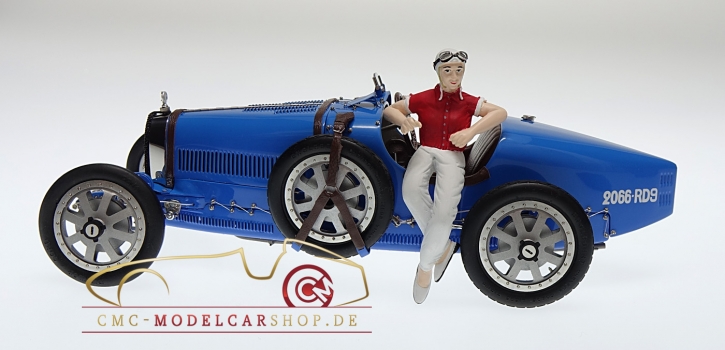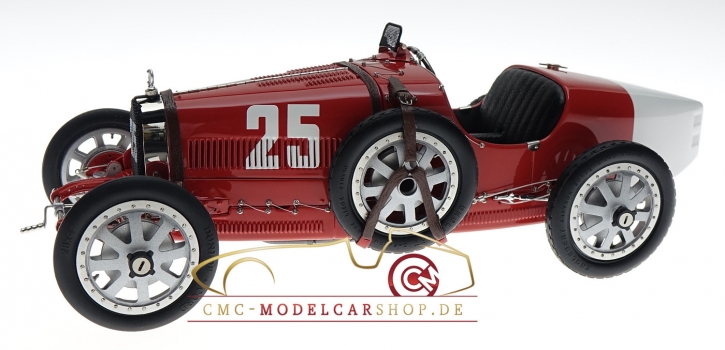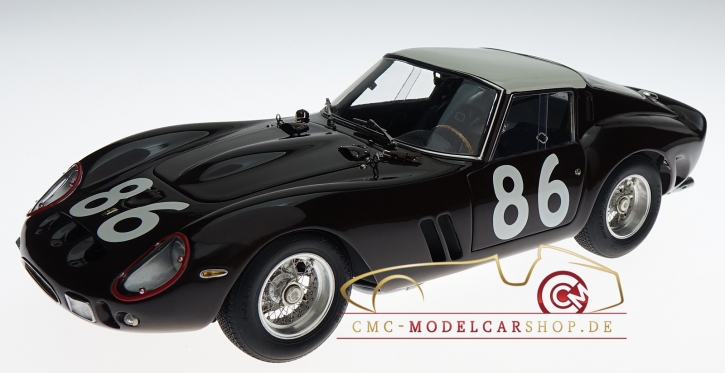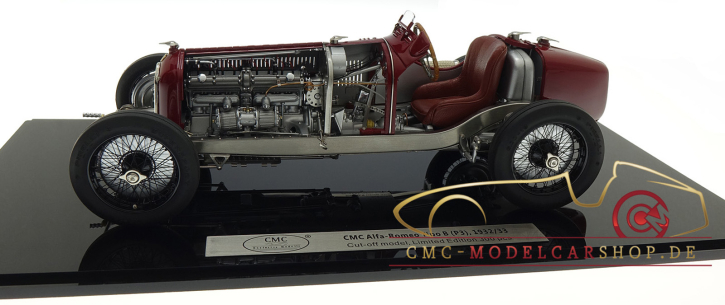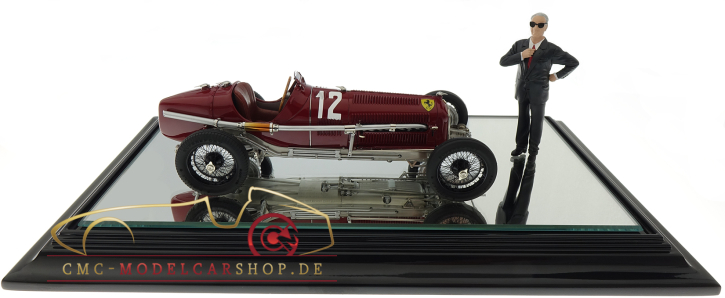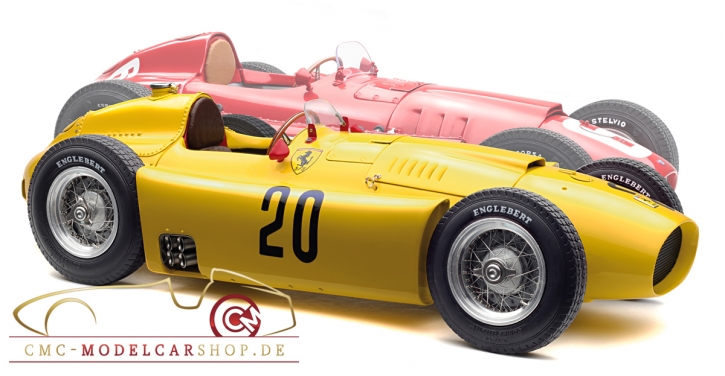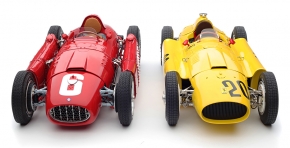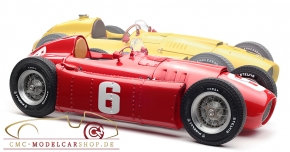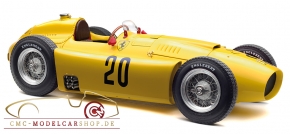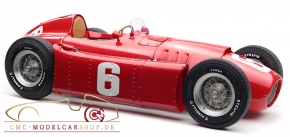CMC Bundle: CMC Ferrari D50, #20 A. Pilette, GP Belgium + CMC Lancia D50, #6 Ascari, GP Turin, Italy
1.048,00 EUR RRP 1.098,00 EUR you save 4.6% (50,00 EUR)
incl. 19 % VAT excl. shipping costs
delivery time: 3-7 days
Product.Nr.: CMC M-184
product description
-
CMC Bundle: CMC Ferrari D50, (yellow) #20 André Pilette, Grand Prix of Belgium 1956 + CMC Lancia D50, (red) #6 Alberto Ascari, Grand Prix of Turin, Italy 1955
It is a pleasure for CMC to introduce to you the developmental history of the D50 race cars in the form of a bundle. The bundle consists of 2 models: The one with #6 is representative of the Lancia D50 from the year 1955, and the one with #20 represents its modified version known as Ferrari D50 from the year 1956.
This bundled edition is limited to 1000 sets worldwide, and the two component replicas are available only in the form of a set.
- Model: Precision model hand-assembled
- Manufacturer: CMC GmbH, Classic Model Cars, Germany
- Scale: 1:18
- Item-No.: M-184
- Color: yellow/red
- Driver: André Pilette/Alberto Ascari
- Parts: ---
- Limited Edition: 1,000
- Ferrari D50:
- Metal precision model hand-built from 1,349 parts
- Detachable and lockable engine-hood
- Flip-open ventilation lid for the driver's footwell
- Detail-exact replication of the V8 engine with accessories, pipes and cabling
- Bundled exhaust pipes made of metal
- Triangular front axle with shock absorbers and transverse leaf spring, all made of metal
- Rear suspension with De-Dion-tube, transverse leaf spring, pushrods and friction dampers, all made of metal
- Oil cooler installed in front of the radiator
- Detailed replication of fuel and oil circulation as well as the cooling system
- Hinged flip-open fuel and oil filler caps
- Upholstered, leather-covered driver's seat and head-rest
- Amazingly realistic and perfectly crafted wheels with stainless-steel spokes and nipples mounted on an alloy rim
- Authentically-replicated central locking nuts with right-/left-handed threads
- Elegant finish by hand in the original hue and color
- Lancia D50:
- Metal precision model hand-built from 1,598 parts
- Detachable and lockable engine hood
- Hinged adjustable screen
- Realistic replica of the V8 engine complete with pipes and cabling
- Metal exhaust pipes
- Triangular steering axle with shock absorbers, front suspension with wishbones, transverse leaf spring, all made of metal
- Rear suspension with De-Dion-tube, transverse leaf spring, longitudinal arms and inboard dampers, all made of metal
- Radiator grille hand-made of stainless steel with metal supports
- Highly-detailed replication of the cooling system
- Highly-detailed fuel and oil circulation
- Authentically-replicated hinged fuel caps
- Authentically-replicated hinged oil-filler cap
- Upholstered leather-covered driver seat and head rest
- Perfectly-crafted wheels with stainless-steel spokes and nipples on an alloy rim
- Authentically-replicated central locking nuts with right-/left-handed threads
- Elegant finish with a brilliant paint in original color
-
Special feature as accessory: Booster trolley with separate assist start device
-
On March 27, the 1955 GP of Turin (also known as the Gran Premio del Valentino) took place in Turin, the capital of Piedmont, Italy. Contestants of this race were to complete 90 laps of its circuit, quivalent to a total distance of 378.0 km. This race event did not contribute points to the world championship.
Congregated on the field were three racing teams -- Lancia, Ferrari and Maserati. Lancia sent its star dri-ver Alberto Ascari in a Lacia D50 with #6. He had Eugenio Castellotti and Luigi Villoresi at his side, who were his teammates. Maserati dispatched a very strong team that consisted of Jean Behra, Luigi Musso and Cesare Perdisa. Ferrari chose to send those deemed to be "most promising candidates", such as Harry Schell, Maurice Trintingnant, Guiseppe Farina and Alfonso de Portago.
In the qulifying practice, Alberto Ascari secured the pole position for himself with 1: 42,0 min. Jean Behra was only 0.2 second slower, thus taking the second place in the front row. Luigi Musso qualified for the third with 1: 43,1 min. Row two was line up with Farina in a Ferrari, Roberto Mieres in a Maserati 250F, and Villoresi in a Lancia D50. Behind them were Trintingnant in a Ferrari and Castellotti in a Lancia D50.
After various position battles by the three racing teams, Ascari took the lead on Lap 22 and got to extend his lead. This went so far that he surpassed his teammate Castellotti during the 60th round. After 90 laps, the finish line was crossed in the order of Villoresi, Castellotti and Ascari. But Alberto Ascari was the clear winner, for he had one lap advantage over the others and won the race in 2 hours and 40 minutes. Roberto Mieres finished second for Maserati. Harry Schell was the only one from the Ferrari team who finished the race and took a fifth place.
This was the first Grand Prix victory for Lancia. For Alberto Ascari, it generated a very sweet sense of achievement after a long dry spell. The last time he had a GP win was dated back to the Grand Prix of Switzerland in1953.
-
Note: The Ascari Model with # 6 has somewhat different looks from the Monaco Standard Model (M-175). The bonnet is cut with 3 luvres only in each of the two ventilation rows and the external oil coolers are relocated to the stub side of the engine.
CMC Lancia D50
Grand Prix of Belgium, 1956
André Pilette # 20, 6th Place
Scale 1: 18
The Grand Prix of Belgium 1965 took place on June 3 at the Circuit de Spa-Francorchamps in the town of Spa, and it was the fourth race of the 1956 World Cup.
Contestants of this race were to complete 36 laps of its circuit, equivalent to a total race distance of 508.32 km. As in the previous races, two Italian racing teams set the tone – Ferrari and Maserati. Both started with five drivers. In addition to its three regulars, namely, Fangio, Castellotti and Peter Collins, Ferrari put two more cars to use by the Belgian national heroes Paul Frère and André Pilette. Although as of 1956, André Pilette was yet to be a winning driver, CMC chose his Ferrari D50 as a component of the bundled set so that CMC can pair a red-finished CMC Lancia D50 with a yellow-finished CMC Ferrari D50 (yellow being the racing color of the Belgians).
Maserati also had its own regulars: Behra, Stirling Moss, Cesare Perdisa, Chico Godia. During the qualifying practice, Juan Manuel Fangio secured his claim to pole position, whereas Moss was able to assert his access to the second place. He was followed by Collins in the third place and Jean Behra in the fourth place. Behind Castellotti in the fifth place were two Vanwall pilots, and then the two Belgian national heroes.
The moment the start flag was lowered, Moss took the lead immediately. Lagging behind by a few places at first, Fangio recovered the lost ground and was right behind Moss before long. With Collins and Castellotti sharing the fourth position at this moment, Maserati was virtually leading the three Ferraris. Fangio pushed more and more on the pace, and slowly he was closing in on the leading Moss. He surpassed Moss on lap five and took the lead. By lap ten, Fongio's lead was increased to a respectable eight seconds.
Then a series of happenings began to break the ranks. Castellotti had to retire with a technical defect in his car. Stirling Moss went off the track after a wheel came off. It enabled Collins to advance to the second position so that Ferrari had a double lead now. Moss managed to take over Perdisa's car and continue with the race, but he was one lap behind leader Fangio.
On lap 23, however, Fangio's car developed a serious engine problem, and the race was over for him. Collins took over the lead, which he did not give up until the end of the race. Behra and Frère dueled for a second-place finish until Behra fell back to the seventh place due to some engine problems.
In the end, Peter Collins gave Ferrari its second win of the season. Frère also secured a 2nd-place title to seal a double victory for Ferrari. After Moss resumed racing in his teammate's car, he fought courageously and finally finished third. Overcoming a one-lap gap, Harry Schell finished fourth. Thanks to a deliberate driving style, André Pilette took a respectable sixth place in his beautifully-finished Ferrari D50 with #20.
-
The use of racing team and/or driver names, symbols, starting numbers, and/or descriptions is solely for reference purposes. Unless otherwise stated, it does not imply that the CMC scale model is a product of any of these racing teams/drivers or endorsed by any of them.
- Ferrari D50:
- Monoposto built on a tubular frame with free-standing wheels
- 2.5-litre V8 engine as a stressed member of the chassis
- Two valves per cylinder controlled by two overhead camshafts
- Dry sump oil lubrication
- Mixture preparation with four Solex 40 PII double carburettors
- Dual ignition (two plugs per cylinder)
- Five-speed manual gearbox installed behind the driver
- Triangular front axle with shock absorbers, front suspension with wishbones, transverse leaf spring, all made of metal
- Rear suspension with De-Dion-tube, transverse leaf spring, pushrods and friction dampers, all made of metal
- Bore x stroke: 76 x 68.5 mm
- Displacement: 2,486 cc
- Maximum output: 265 HP at 8,000 rpm
- Top speed: 300 Km/h (depending on ratio)
- Wheelbase: 2,280 mm
- Track front/rear: 1,270 / 1,270 mm
- Total length: 3, 850 mm
- Total width: 1,448 mm
- Total height: 962 mm
- Curb weight: 640 kg
- Lancia D50:
- Monoposto built on a tubular frame with free-standing wheels
- 2.5-litre V8 engine as a stressed member of the chassis
- Two valves per cylinder controlled by two overhead camshafts
- Dry sump oil lubrication
- Mixture preparation with four Solex PII double carburettors
- Dual ignition (two plugs per cylinder)
- Five-speed manual gearbox installed behind the driver
- Bore x stroke: 73.6 x 73.1 mm
- Displacement: 2,488 cc
- Maximum output: 260 HP at 8,000 rpm
- Top speed: 300 Km/h (depending on ratio)
- Wheelbase: 2,280 mm
- Track front/rear: 1,294 / 1,330 mm
- Total length: 3,570 mm
- Total width: 1,600 mm
- Total height: 1,001 mm
- Curb weight: 620 kg
Review(s)
Wrote by Patrick B. on 20.09.2020
Duo exceptionnel
Duo historique aux couleurs magnifiques. Très belle reconstitution et réalisation soignée de ces deux "bêtes de course". Tout simplement magnifique.
Wrote by Hans M. on 20.11.2019
CMC Bundle: CMC Ferrari D50, GP Belgien #20 A.Pilette + CMC Lancia D50 GP Turin #6 Ascari
Alles Top, inklusive Vorauszahlung auf Bank. Verpackung super, zeitgemäss. Bin sehr zufrieden. Danke.













